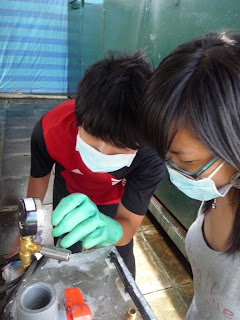COLLECTION OF WASTE
Fig 1: Our group members were well equipped with gas masks.
Fig 2: Carrying of buckets and containers filled with waste to an appropriate location for mixing.
EXPERIMENTAL RUN 1
The procedures for the experimental run on the prototype were developed weeks ahead and are as follows:
Anaerobic Digestion
1. Collect sample of the raw sludge before loading.
2. Ensure that all valves are closed.
3. Load sludge through the loading port and open V1 to allow sludge to enter the 1st Chamber and close V1 after loading is completed.
4. Open V8 to allow any liquid to be drained from the 1st chamber towards the liquid drain.
5. Ensure that there is a container at the other side of the filter to collect the filtrate.
6. Ensure that the tubing connecting the methane capture system and digester between V12 and V7 is connected.
7. Open V12 and V7 to allow gases to pass through to the methane capture system.
8. Stir the sludge in the chamber manually to ensure even mixing.
9. Open V4 slightly first then fully to measure the pressure using the pressure gauge attached.
10. Leave the system to run for approximately 10 days
Fig 1: Ensuring that all valves are are closed again after loading.
Fig 2: Checking all instrumentations once again after loading.
Fig 3: Freshly loaded sludge in the Anaerobic Chamber.
Fig 4: Close up view of loaded sludge
Fig 5: Prototype covered with a thick black cloth to simulate the same surroundings as that in the actual closed up digester.
For this run, we experienced many setbacks due to the delay of the completion of the prototype. The group had decided to use fresh sludge because the sludge collected and accumulated from the farm's toilet might have been pre-digested prior to the experiment, giving rise to inaccurate results. As the run had to be quickly started, it was even harder for us to collect fresh human waste. There were much unwillingness among many whom we pleaded with, largely due to embarrassment and the unethical, controversial aspect of our project which requires fresh collection of human waste. However, we managed to find volunteers that were willing to contribute to our experimental run and whom we are extremely grateful to. To spur on the collection, the group bought Yakult and Bananas, food etc to feed the volunteers. After which, equipped with masks and chemical gloves, we mixed the waste together in a ventilated area with a long pole in a bucket, at the same time diluting the mixture with toilet water.
Reflection: The loading was an extremely challenging and nightmarish experience. Despite doing it in an open area, the smell issuing from the bucket of waste was nauseating and ghoulish. Even with masks, we could still inhale the autrocious smell. The apparatus supplied to us to aid us in the loading were inadequate in quality. The scoop to transfer the waste from the bucket slowly to the loading port was cracked and giving way and the funnel used to channel the waste into the port was cracked at the edge. Hence the waste liquid spurted from the cracks and caused much spillages. It was already tough avoiding the spillages and small splashes of waste leaking from the cracked apparatus, but worse was to come when the relatively solid waste caused clogging at the loading port. One of our group members had to reach in through the funnel and jab the solid waste through the loading port. Swarms of flies came within seconds of our loading and added to the frustration. Despite losses, we were still able to obtain the volume specified before. After the loading, we proceeded to wash up the entire area, leaving no drops of waste on the prototype and the ground and lastly with a touch of air refresheners. Despite the many obstacles, we were able to bear through the loading and successfully start the anaerobic stage. This experience has led us to plan a better way of loading the waste for the subsequent run.







0 comments:
Post a Comment